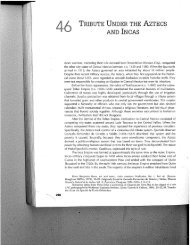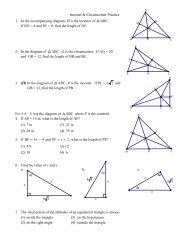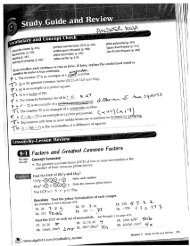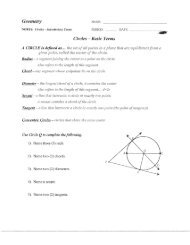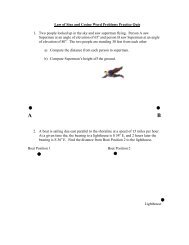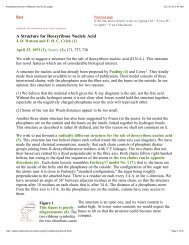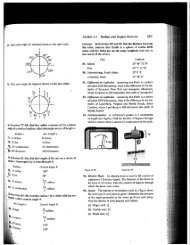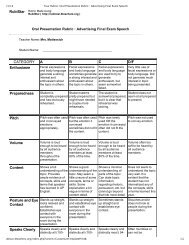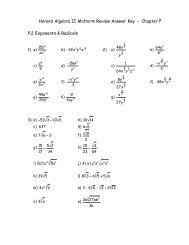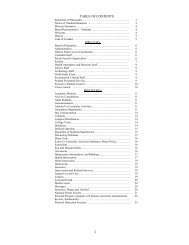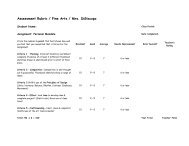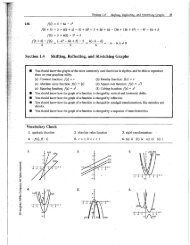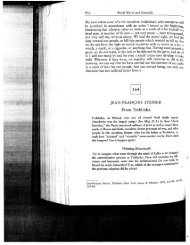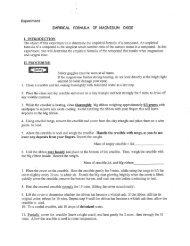You also want an ePaper? Increase the reach of your titles
YUMPU automatically turns print PDFs into web optimized ePapers that Google loves.
7 <strong>Linear</strong> <strong>Momentum</strong><br />
Conceptual Questions<br />
1) What is the SI unit of momentum<br />
A) N’m<br />
B)N/s<br />
C)N’s<br />
D) N/m<br />
2) When a cannon fires a cannonball, the cannon will recoil backward because the<br />
A) energy of the cannonball and cannon is conserved.<br />
B) momentum of the cannonba!l and cannon is conserved.<br />
C) energy of the cannon is greater than the energy of the cannonball.<br />
D) momentum of the cannon is greater than the energy of the cannonball.<br />
3) A freight car moves along a frictionless level railroad track at constant speed. The car is open on top. A<br />
large load of coal is suddenly dumped into the car. What happens to the velocity of the car<br />
A) It increases.<br />
B) It remains the same.<br />
C) It decreases.<br />
D) cannot be determined from the information given<br />
4) A child falls sideways offa sled while sledding on frictionless ice. What happens to the velocity of the<br />
sled<br />
A) It increases.<br />
B) It remains the same.<br />
C) It decreases.<br />
D) cmmot be determined from the information given<br />
5) A rubber ball and a lump of putty have equal mass. They are thrown with equal speed against a wall.<br />
The ball bounces back with nearly the same speed with wlich it hit. The putty sticks to the wall. Which<br />
objects experiences the greater momentum change<br />
A) the ball<br />
B) the putty<br />
C) Both experience the same momentum change.<br />
D) cannot be determined from the information given
6) A sailboat of mass m is moving with a momentum p. How would you represent its kinetic energy in<br />
terms of these two quantities<br />
A) p2/(2m)<br />
B) 1/2 mp2<br />
C) mp<br />
D) rap/2<br />
7) If you pitch a b~eball with twice the kinetic energy you gave it in the previous pitch, the magnitude of<br />
its momentum is<br />
A) the same.<br />
B) 1.41 times as much.<br />
C) doubled.<br />
D) 4 times as much.<br />
8) State Newton’s second law in terms ofnaomentum.<br />
9) State the law of conservation ofmomentmn.<br />
10) The area under the curve on a Force versus time (F vs. t) graph represents<br />
A) impulse.<br />
B) momentum.<br />
C) work.<br />
D) kinetic energy.<br />
1 I) Which of the following is an accurate statement<br />
A) The momentum of a projectile is constant.<br />
B) The momentum of a moving object is constant.<br />
C) If an object is acted on by a non-zero net external force, its momentum will not remain constant.<br />
D) If the kinetic energy of an object is doubled, its mmnentum will also double.<br />
12) A small car meshes with a large truck in a head-on collision. Which of the following statements<br />
concerning the magnitude of the average collision force is correct<br />
A) The truck experiences the greater average force.<br />
B) The small car experiences the greater average force.<br />
C) The small car and the truck experience the same average force.<br />
D) It is impossible to tell since the masses and velocities are not given.
13) Two equal mass balls (one red and the other blue) are dropped from the same height, and rebound off<br />
the floor. The red ball rebounds to a higher position, Which ball is subjected to the greater magnitude of<br />
impulse during its collision with the floor<br />
A) It’s impossible to tell since the time intervals and forces are unknown.<br />
B) Both balls were subjected to the same magnitude impulse.<br />
C) the blue ball<br />
D) the red ball<br />
14) A Ping-Pong ball moving east at a speed of 4 m/s, collides with a stationary bowling ball. The Ping-<br />
Pong ball bounces back to the west, and the bowling ball moves very slowly to the east. Which object<br />
experiences the greater magnitude impulse during the collision<br />
A) Neither; both experienced the same magnitude impulse.<br />
B) the Ping-Pong ball<br />
C) the bowling ball<br />
D) It’s impossible to tell since the velocities after the collision are unknown.<br />
15) Two objects collide and bounce offeach other. <strong>Linear</strong> momentum<br />
A) is definitely conserved.<br />
B) is definitely not conserved.<br />
C) is conserved only if the collision is elastic.<br />
D) is conserved only if the environment is frictionless.<br />
4<br />
16) A 3.0-kg object moves to the right at 4.0 m/s. It collides head-on with a 6.0-kg object moving to the<br />
left at 2.0 m/s. Which statement is correct<br />
A) The total momentum both before and after the collision is 24 kg" m/s.<br />
B) The total momentum before flae collision is 24 kg.m/s, and after the collision is 0 kg-ln/s.<br />
C) The total momentum both before and after the collision is zero.<br />
D) None of the above is true.<br />
17) A 100-kg football linebacker moving at 2.0 m/s tackles bead-on an 80-kg halfback running 3.0 m/s.<br />
Neglecting the effects due to digging in of cleats,<br />
A) the linebacker will drive the halfback backward.<br />
B) the halt’back will drive the linebacker backward.<br />
C) neither player will drive the other backward.<br />
D) this is a simple example of an elastic collision.<br />
18) In an elastic collision, if the momentum is conserved, then which of the following statements is true<br />
about kinetic energy<br />
A) Kinetic energy is also conserved.<br />
B) Kinetic energy is gained.<br />
C) Kinetic energy is lost.<br />
D) none of the above<br />
19) When is kinetic energy conserved<br />
A) in elastic collisions<br />
B) in inelastic collisions<br />
C) in any collision in which the objects do not stick together<br />
............................................................... D) irr~all collisions ......................................................................................................................................................................................................................................................
20) In a game of pool, the white cue ball hits the #5 ball and stops, while the #5 ball moves away with the<br />
same velocity as the cue ball had originally. The type of collision is<br />
A) elastic.<br />
B) inelastic.<br />
C) completely inelastic.<br />
D) any of the above, depending on the mass of the balls.<br />
21) When a light beach ball rolling with a speed of 6.0 m/s collides with a heavy exercise ball at rest, the<br />
beach bali’s speed after the collision will be, approximately,<br />
A)O.<br />
B) 3.0 m/s.<br />
C) 6.0 m/s.<br />
D) 12 m/s.<br />
22) A golf ball traveling 3.0 m/s to the right collides in a head-on collision with a stationary bowling ball<br />
in a friction-free environment. If the collision is almost perfectly elastic, the speed of the golf ball<br />
immediately after the collision is<br />
A) slightly less than 3.0 m/s.<br />
B) slightly greater than 3.0 m/s.<br />
C) equal to 3.0 m/s.<br />
D) much less than 3.0 m/s.<br />
23) A rubber ball with a speed of 5.0 m/s collides head-on elastically with an identical ball at rest. What is<br />
the speed of the initially stopped ball after the collision<br />
A) zero<br />
B) 1.0 m/s<br />
C) 2.5 m/s<br />
D) 5.0 m/s<br />
24) A very heavy object moving with speed v collides head-on with a very light object at rest, The<br />
collision is elastic, and there is no friction. The heavy object barely slows down. What is the speed of the<br />
light object after the collision<br />
A) nearly v<br />
B) nearly 2v<br />
C) nearly 3v<br />
D) nearly infinite<br />
25) A very light object moving with speed v collides head-on with a very heavy object at rest, in a<br />
frictionless environment. The collision is almost perfectly elastic, The speed of the heavy object after the<br />
collision is<br />
A) slightly greater than v.<br />
B) equal to v,<br />
C) slightly less than v.<br />
D) much less than v.<br />
26) A red ball with a velocity of +3.0 m/s collides head-on with a yellow ball of equal mass moving with a<br />
velocity of-2.0 m!s. What is the velocity of the yellow ball after the collision<br />
A) zero<br />
B) +3.0 m/s<br />
C) -2.0 m/s<br />
................................................................... D) ~5.~/~ ......................................................................................................................................
27) A very heavy object moving with velocity v collides head-on with a very light object moving with<br />
velocity -v. The collision is elastic, and there is no frictiofi. The heavy object barely slows down. What is<br />
the speed of the light object after the collision<br />
A) nearly v<br />
B) nearly 2v<br />
C) nearly 3v<br />
D) nearly infinite<br />
28) In an inelastic collision, if the momentum is conserved, then which of the following statements is true<br />
about kinetic energy<br />
A) Kinetic energy is also conserved.<br />
B) Kinetic energy is gained.<br />
C) Kinetic energy is lost.<br />
D) none of the above<br />
29) Two objects collide and stick together. Kinetic energy<br />
A) is definitely conserved.<br />
B) is definitely not conserved.<br />
C) is conserved only if the collision is elastic.<br />
D) is conserved only if the environment is frictionless.<br />
30) A 3.0-kg object moves to the right at 4.0 m/s. It collides in a perfectly inelastic collision with a 6.0 kg<br />
object moving to the left at 2.0 m/s. What is the total kinetic energy after the collision<br />
A) 72 J<br />
B) 36 J<br />
C) 24 J<br />
o)0J<br />
31) A small object collides with a large object and sticks.. Which object experiences the larger magnitude<br />
of momentum change<br />
A) the large object<br />
B) the small object<br />
C) Both objects experience the same magnitude of momentum change.<br />
D) cannot be determined from the information given<br />
32) In a game of pool, the white cue ball hits the #9 ball and is deflected at a 35 ° angle to the original line<br />
of motion. What is the angle of deflection below the original line of motion for the #9 ball<br />
A) 35 °<br />
B) 55 °<br />
C) 75 °<br />
D) 90 °<br />
33) Consider two unequal masses, M and m. Which of the following statements is false<br />
A) The center of mass lies oa the line joining the centers of each mass.<br />
B) The center of mass is closer to the larger mass.<br />
C) It is possible for the center of mass to lie within one oflbe objects.<br />
D) If a uniform rod of mass m were to join the two masses, this would not alter the position of the center of<br />
mass of the system without the rod present.
34) Which of the following is a false statement<br />
A) For a uniform symmetric object, the center of mass is at the center of symmetry.<br />
B) For an object on the surface of the Earth, tbe center of gravity and the center of mass are the same point.<br />
C) The center of mass of an object must lie within the object.<br />
D) The center of gravity of an object may be thought of as the "balance point."<br />
35) Tightrope walkers walk with a long flexible rod in order to<br />
A) increase their total weight.<br />
B) allow both hands to hold onto something.<br />
C) lower their center of mass.<br />
D) move faster along the rope.<br />
36) A plane, flying horizontally, releases a bomb, which explodes before hitting the ground. Neglecting<br />
air resistance, the center of mass of the bomb fragments, just after the explosion<br />
A) is zero.<br />
B) moves horizontally.<br />
C) moves vertically.<br />
D) moves along a parabolic path.
37) Two cars collide head-on on a level friction-free road. The collision was completely inelastic and both<br />
cars quickly came to rest during the collision. What is true about the velocity of this system’s center of<br />
mass~<br />
A) It was always zero,<br />
B) It was never zero.<br />
C) It was not zero, but ended up zero.<br />
D) none of the above<br />
38) State Newton’s second law for a system of particles,<br />
Answer: The sum of all forces acting on the system is equal to the total mass of the system times the<br />
acceleration of its center of mass.<br />
Quantitative Problems<br />
1) What is the momentum ofa 2000-kg truck traveling at 35 m/s<br />
A) 57 kg.m/s<br />
B)3,5 x 104 kg’m/s<br />
C)7.0 x 104 kg.m/s<br />
D) 7.0 × 105 kg’m/s<br />
2) A 1200-kg ferryboat is moving south at 20 m/s. What is the magnitude of its momentum<br />
A) 1.7 x 10-3 kg’m/s<br />
B)6,0 x 102 kg.m/s<br />
C)2.4 x 103 kg,m/s<br />
D)2.4 x 104 kg’m/s<br />
3) A bail of mass 0.10 kg is dropped from a height of 12 m. Its momentum when it strikes the ground is<br />
A) 1.5 kg.m/s.<br />
B) 1.8 kg’m/s.<br />
C) 2.4 kg’m/s.<br />
D) 4.8 kg-m/s.<br />
4) Two identical 1500-kg cars are moving perpendicular to each other. One moves with a speed of 25 m/s<br />
due north and the other moves at 15 m/s due east. What ig the total momentum of the system<br />
A) 4.4 x 104 kg’m/s at 31 ° N ore<br />
B) 4.4 x 104 kg’m/s at 59 ° N of E<br />
C) 6.0 x 104 kg’m/s at 31 ° N of E<br />
D) 6.0 × 104 kg’m/s at 59 ° N orE
5) A handball of mass 0.10 kg, traveling horizontally at 30 m/s, strikes a wall and rebounds at 24 m/s.<br />
What is the change in the lnomentum of the ball<br />
A) 0.60 kg-m/s<br />
B) 1.2 kg’m/s<br />
C) 5.4 kg’m/s<br />
D) 72 kg’m/s<br />
6) A 0.060-kg tennis ball, initially moving at a speed of 12 m/s, is struck by a racket causing it to rebound<br />
in the opposite direction at a speed of 18 m/s. What is the change in momentum of the ball<br />
A) 0.36 kg’m/s<br />
B) 0.72 kg’m/s<br />
C) 1.1 kg.m/s<br />
D) 1.8 kg’m/s<br />
7) A 50-kg pitching machine (excluding the baseball) is placed on a frozen pond, The machine fires a<br />
0.40-kg baseball with a speed of 35 m/s in the horizontal direction. What is the recoil speed of the pitching<br />
machine (Assume negligible friction.)<br />
A) 0.14 m/s<br />
B) 0,28 m/s<br />
C) 0.70 nq/s<br />
D) 4,4 x 103 m/s<br />
8) A 70-kg astronaut is space-walking outside the space capsule and is stationary when the tether line<br />
breaks, As a means of returning to the capsule he throws his 2.0-kg space hammer at a speed of 14 m/s<br />
away from the capsule. At what speed does the astronaut move toward the capsule<br />
A) 0.40 m/s<br />
B) 1.5 m/s<br />
C) 3,5 m/s<br />
D) 5.0 m/s<br />
9) A small object with momentum 5.0 kg,m/s approaches head-on a large object at rest. The small object<br />
bounces straight back with a momentum of magnitude 4.0 kg. m/s. What is the magnitude of the large<br />
object’s momentum change<br />
A) 9.0 kg-m/s<br />
B) 5.0 kg.m/s<br />
C) 4.0 kg’m/s<br />
D) 1.0 kg-m/s
10) You (50-kg mass) skate on ice at 4.0 m/s to greet your friend (40-kg mass), who is standing still, with<br />
open arms. As you collide, while holding each other, with what speed do you both move offtogether<br />
A) zero<br />
B) 2.2 m/s<br />
C) 5.0 m/s<br />
D) 23 m/s<br />
11) A car of mass 1000 kg moves to the right along a level, straight road at a speed of 6.0 m/s. It collides<br />
directly with a stopped motorcycle of mass 200 kg. What is the total momentum after the collision<br />
A) zero<br />
B) 6000 kg.m/s to the right<br />
C) 2000 kg.m/s to the right<br />
D) 10,000 kg-m/s to the right<br />
12) A 1000-kg car traveling at 25 m/s runs into the rear of a stopped car that has a mass of 1500 kg and<br />
they stick together. What is the speed of the cars after the collision<br />
A) 5.0 m/s<br />
B) 10 m/s<br />
C) 15 m/s<br />
D) 20 m/s<br />
13) A railroad freight car, mass 15,000 kg, is allowed to coast along a level track at a speed of 2.0 m/s. It<br />
collides and couples with a 50,000-kg second car, initially at rest and with brakes released. What is the<br />
speed of the two cars after coupling<br />
A) 0.46 m/s<br />
B) 0.60 m/s<br />
C) 1.2 m/s<br />
D) t.8 m/s<br />
14) A railroad car, of mass 200 kg, rolls with negligible friction on a horizontal track with a speed of 10<br />
m/s. A 70-kg stunt man drops straight down a distance of 4.0 m, and lands in the car. How fast will the car<br />
be moving after this happens<br />
A) 2.8 m/s<br />
B) 4.7 m/s<br />
C) 7.4 m/s<br />
D) 10 m/s
15) A 60-kg person walks on a 100-kg log at the rate of 0:80 m/s (with respect to the log). With what<br />
speed does the log move, with respect to the shore<br />
A) 0,24 m/s<br />
B) 0.30 m/s<br />
C) 0.48 m/s<br />
D) 0~60 m/s<br />
16) A 4.0-N force acts for 3.0 s on an object. The force suddenly increases to 15 N and acts for one more<br />
second. What impulse was imparted by these forces to the object<br />
A) 12 N’s<br />
B) 15 N’s<br />
C) 19 N’s<br />
D) 27 N’s<br />
17) A constant 9.0-N net force acts for 2.0 s on a 6.0-kg object. What is the object’s change of velocity<br />
A) 3.0 m/s<br />
B) 9.0 m/s<br />
C) 27 m/s<br />
D) 110 m/s<br />
Answer: A<br />
Diff: l Type: BI Vat: 3 Page Ref: See. 7.3<br />
18) A 2000-kg car, traveling to the right at 30 m/s, collides with a brick wall and comes to rest in 0.20 s.<br />
What is the average force the car exerts on the wall<br />
A) 12,000 N to the right<br />
B) 300,000 N to the right<br />
C) 60,000 N to the right<br />
D) none of the above<br />
Answer: B<br />
Diff.. ] Type: BI Van: 1 Page Re39: See. 7.3<br />
19) A 2.0-kg softball is pitched to you at 20 m/s. You hit the ball back along the same path, and at the<br />
same speed, lfthe bat was in contact with the ball for 0.10 s, what is the magnitude of the average force<br />
the bat exerted<br />
A) zero<br />
B)40N<br />
C) 400 N<br />
D) 800 N<br />
20) A 0.10-kg ball is dropped onto a table top. The speeds of the ball right before and right after hi~ing<br />
the table top are 5.0 m/s and 4.0 m/s, respectively. If the collision between the ball and the table top lasts<br />
0.15 s, what is the magnitude of the average force exerted on the ball by the table top<br />
A) 0.67 N<br />
B) 1.3 N<br />
c) 3.0 N<br />
D) 6.0 N
21) A machine gun, of mass 35.0 kg, fires 50.0-gram bullets, with a muzzle velocity of 750 m/s, at the rate<br />
of 300 rounds per minute. What is the average force exerted on the machine gun mount<br />
A) 94.0 N<br />
B) 188 N<br />
C)219N<br />
D) 438 N<br />
22) A fire hose is turned on the door of a burning building in order to knock the door down. This requires<br />
a force of 1000 N. If the hose delivers 40 kg per second, what is the minimum velocity of the stream<br />
needed, assuming the water doesn’t bounce back<br />
A) 15 m/s<br />
B) 20 m/s<br />
C) 25 m/s<br />
D) 30 m/s<br />
23) Water runs out of a horizontal drainpipe at the rate of 120 kg per minute. It falls 3.20 m to the ground.<br />
Assuming the water doesn’t splash up, what average force does it exert on the ground<br />
A) 6.20 N<br />
B) 12.0 N<br />
C) 15.8 N<br />
D) 19.6 N<br />
24) A toy rocket, of mass 0.12 kg, achieves a velocity of 40 m/s after 3.0 s, when fired straight up: What<br />
average thrust force does the rocket engine exert<br />
A) 1.2 N<br />
B) 1.6 N<br />
C) 2.8 N<br />
D) 4.4 N<br />
25) Two astronauts, of masses 60 kg and 80 kg, are initially at rest in outer space. They push each other<br />
apart. What is their separation after the lighter astronaut t~as moved 12 m<br />
A) 15 m<br />
B) IBm<br />
C) 21 m<br />
D) 24 m<br />
26) A 3.0-kg object moves to the right with a speed of 2.0 m/s. It collides in a perfectly elastic collision<br />
with a 6.0-kg object moving to the left at 1.0 m/s. What is the total kinetic energy after the collision<br />
A) 9.0 J<br />
6.0 J<br />
c) 3.0 J<br />
D)OJ<br />
27) A 0.10-kg object with a velocity of 0.20 m/s in the +x direction makes a head-on elastic collision with<br />
a 0.15 kg object initially at rest. What is the final velocity of the 0A0-kg object after collision<br />
A) -0.16 m/s<br />
g) 4.6~. i~ Tn-f~ ................................................................................................................................................<br />
C) -0.040 m/s<br />
D) +0.040 m/s
28) A 10.0-g bullet moving at 300 m/s is fired into a 1.00-kg block at rest. The bullet emerges (the bullet<br />
does not get embedded in the block) with half of its original speed. What is the velocity of the block right<br />
after the collision<br />
A) 1.50 m/s<br />
B) 2.97 m/s<br />
C) 3.00 m/s<br />
D) 273 m/s<br />
29) A proton, of mass m, at rest, is struck head-on by an alpha-particle (which consists of 2 protons and 2<br />
neutrons) moving at speed v. Iftbe collision is completely elastic, what speed will the alpha-particle have<br />
after the collision (Assume the neutron’s mass equals the proton’s mass.)<br />
A) zero<br />
B) 2v/3<br />
c) 3v/5<br />
5v/3<br />
30) A 50-gram ball moving +10 m/s collides head-on witl~ a stationary ball of mass 100 g. The collision is<br />
elastic. What is the speed of each ball immediately after the collision<br />
A) -3.3 m/s and +6.7 m/s<br />
B) +3.3 m/s and -6.7 m/s<br />
C) -6.7 m/s and +3.3 m/s<br />
D) +6.7 m/s and -3.3 m/s<br />
31) A ball of mass 400 g moving toward the east with a speed of 3.70 m/s collides head-on with a200 g<br />
ball sitting at rest. The collision is perfectly elastic.<br />
(a) Determine the velocity of the first ball after the collision.<br />
(b) Determine the velocity of the second ball after the collision.<br />
(c) Is kinetic energy conserved in this collision
32) A 2.0-kg mass moves with a speed of 5.0 m/s. It collides head-on with a 3.0 kg mass at rest. If the<br />
collision is perfectly inelastic, what is the speed of the masses after the collision<br />
A) 10 m/s<br />
B) 2.5 m/s<br />
C) 2.0 m/s<br />
D) 0, since the collision is inelastic<br />
33) A 2.0-kg mass moving to the east at a speed of 4.0 m/s collides head-on in a perfectly inelastic<br />
collision with a stationary 2.0-kg mass. How much kinetic energy is lost during this collision<br />
A) 16J<br />
B) 4.0 J<br />
C) 8.0 J<br />
D) zero<br />
34) A car of mass m, traveling with a velocity v, strikes a parked station wagon, who’s mass is 2m. The<br />
bumpers lock together in this head-on inelastic collision. What fraction of the initial kinetic energy is lost<br />
in this collision<br />
A) ~/2<br />
B)<br />
C) 1/4<br />
D) 2/3<br />
35) A 15-g bullet traveling 213 m/s in a vertical direction buries itself in a 2.4 kg block of wood at rest<br />
directly above it. As a result, the bullet/block combination moves vertically upward.<br />
(a) Determine the velocity of the bullet/block combination at the point of impact.<br />
(b) Determine the maximum height reached by the bullet/block combination.<br />
(c) Is kinetic energy conserved in this collision
90,0 km/h<br />
FIGURE 7-1<br />
36) A 1500-kg cm" traveling at 90.0 km/h east collides with a 3000-kg car traveling at 60.0 km/h south.<br />
The two cars stick together after the collision. (See Fig. 7-1 .) What is the speed of the cars after collision<br />
A) 8.33 m/s<br />
B) 13.9 m/s<br />
C) 17.4 m/s<br />
D) 21.7 m/s<br />
37) A 1500-kg car traveling at 90.0 km/h east collides with a 3000-kg car traveling at 60.0 km/h south.<br />
The two cars stick together after the collision. (See Fig. 7-1.) What is the direction of motion of the cars<br />
after collision<br />
A) 36.9 ° S of E<br />
B) 36.9 ° E ors<br />
C) 53.1 ° S of E<br />
D) 53.1 ° EofS<br />
38) Two objects move on a level frictionless surface. Object A moves east with a momentum of 24<br />
kg.m/s. Object B moves north with momentum 10 kg’m/s. They make a perfectly inelastic collision. What<br />
is the magnitude of their combined momentum after the collision<br />
A) 14 kg.m/s<br />
B) 26 kg.m/s<br />
C) 34 kg-m/s<br />
D) cannot be determined without knowing masses and velocities
39) A small bomb, of mass 10 kg, is moving toward the North with a velocity of4.0 m/s. It explodes into<br />
three fragments: a 5.0-kg fragment moving west with a speed of &0 m/s; a 4.0-kg fragment moving east<br />
with a speed of 10 m/s; and a third fi’agment with a mass of 1.0 kg. What is the velocity of the third<br />
fragment (Neglect air friction.)<br />
A) zero<br />
B) 40 m/s north<br />
C) 40 m/s south<br />
D) none of the above<br />
40) A 4.00-kg mass sits at the origin, and a 10.0-kg mass sits at x = + 21.0 m. Where is the center of mass<br />
on the x-axis<br />
A) +7.00 m<br />
B) +10.5 m<br />
C) +14.0 m<br />
D) +15.0 m<br />
41) The center of mass of a two-particle system is at the origin. One particle is located at (3.0 m, 0) and<br />
has a mass of 2.0 kg. What is the location of the second mass of 3.0 kg<br />
A) (-3.0 m, 0)<br />
B) (-2.0 m, 0)<br />
c) (2.o m, o)<br />
D) (3.0 m, 0)<br />
42) Three masses are positioned as follows: 2.0 kg at (0, 0), 2.0 kg at (2.0, 0), and 4.0 kg at (2.0, 1.0).<br />
Determine the coordinates of the center of mass.<br />
~) (0.50, 1.5)<br />
B) (1.5, 0.50)<br />
C) (2.5, 1.5)<br />
D) (2.5, 0.50)<br />
43) Three masses, 1.0 kg, 2.0 kg, and 3.0 kg, are located at (0, 0), (1.0 m, 1.0 m), and (2.0 m, -2.0 m),<br />
respectively. What is the location of the center of mass of the system<br />
A) (1.3 m, 0.67 m)<br />
B) (1.3 m, -0.67 m)<br />
C) (-1.3 m, 0.67 m)<br />
D) (-1.3 m, -0.67 m)
44) A 3.0-kg mass is positioned at (0, 8.0), and a 1.0-kg mass is positioned at (12, 0). What are the<br />
coordinates of a 4.0-kg mass which will result in the center of mass of the system of three masses being<br />
located at the origin, (0, 0)<br />
A) (-3.0, -6.0)<br />
~) (-12, -8.0)<br />
C) (3.0, 6.0)<br />
D) (-6.0, -3.0)



